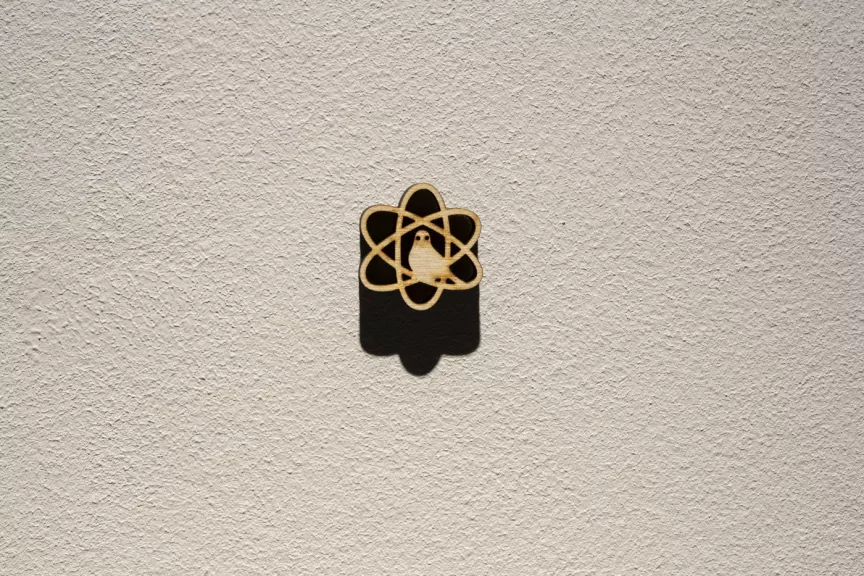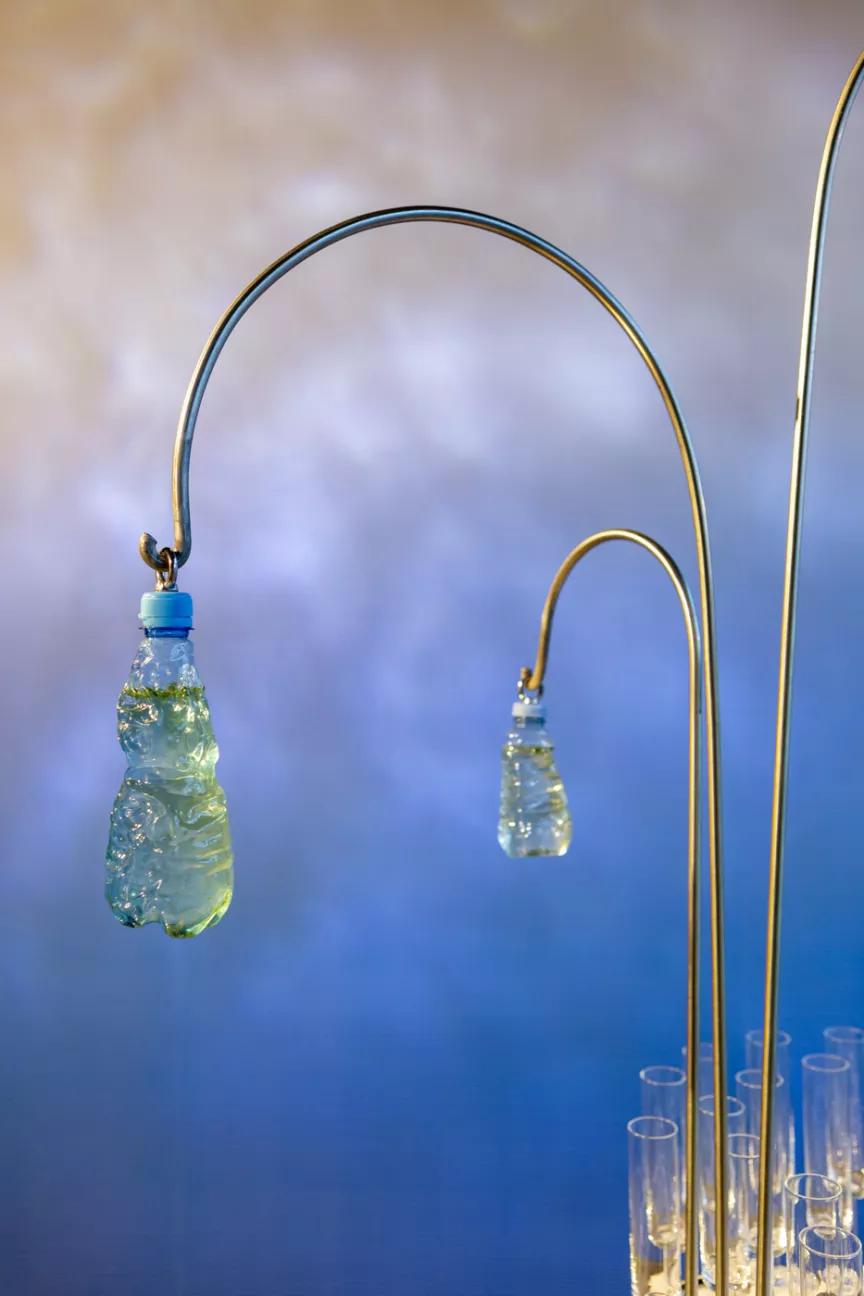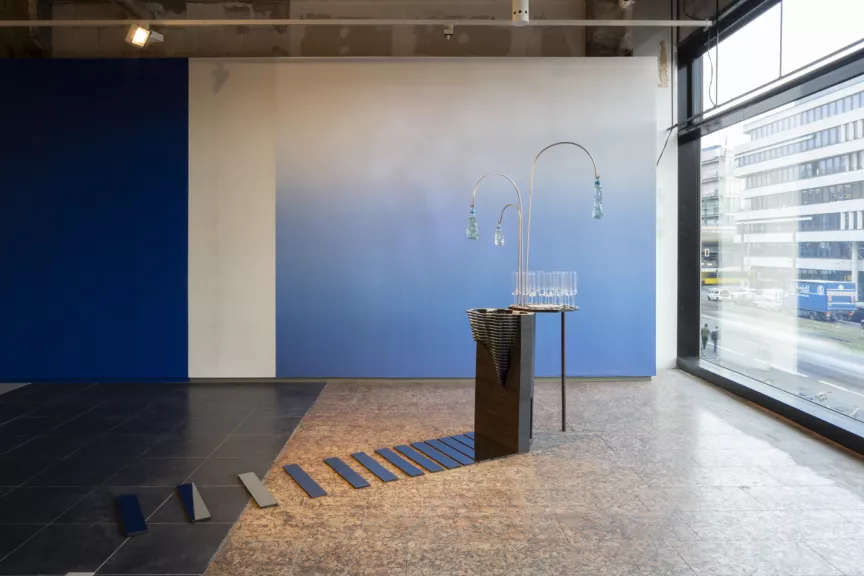Marike Schreiber


Radiant Lake
Multimedia installation with bar sculpture, medal and jewelry box, wallpaper, audio; "="$
In September 2024, Marike Schreiber realized an artist-led field trip as part of SALT. CLAY. ROCK. with the former Rheinsberg nuclear power plant in northern Brandenburg and the surrounding Stechlin nature reserve as her destinations. Interested in this unique entanglement of nuclear energy production and nature preservation, her artistic research focused on the Great Stechlin Lake, which had played a crucial role as the natural "cooling system" of the power plant, and is widely known for its remarkable water quality and rich biodiversity as a freshwater lake. In 1959, the Department of Experimental Limnology (the study of inland waters), a branch of the Central Institute for Microbiology and Experimental Therapy (ZIMET) in Jena, was established here, with the primary aim of studying the effects of the nuclear power plant on the lake. This resulted in one of the most comprehensive long-term data series of limnology globally. After the German reunification, in 1992, a new research institute with an experimental station on Stechlin Lake was created. It received its present name "Leibniz Institute for Freshwater Ecology and Inland Fisheries" in 2000, following its inclusion in the Leibniz Association. Today scientists working here predominantly focus on the impact of climate change on the lake's ecosystem, drawing on the long-term data collected during the operation of the nuclear power plant.
In the frame of SALT. CLAY. ROCK., the Rheinsberg nuclear power plant (NPP) and its history are central to examining the legacy of nuclear infrastructures. In 1966, this was the first nuclear power plant to go into operation in East Germany (GDR), and since 1995, it is the first one to be decommissioned and turned into a “green field”.
Both Marike Schreiber's artist-led field trip and her work for the exhibition explore this history, highlighting its contradictions and controversies. An important point of departure is the nuclear power plant's main gate, which until today features a peace dove, an omnipresent political symbol of the GDR that referenced the "peaceful atom", the allegedly peaceful use of nuclear energy in the midst of the Cold War. When the Rheinsberg NPP was opened, all the workers participating in its construction received one of two thousand specially minted medals. The front side showed the peace dove within a drawing of the atom, while the back side read: "In recognition of your contribution to the first nuclear power plant of the GDR, Rheinsberg, 9.5.166."
Marike Schreiber’s work also addresses the legacy of the Environmental Sundays (Umweltsonntage), a series of events initiated by Reinhard Dalchow, a pastor at the Protestant church in the nearby Menz during the 1980s. The goal of these Sunday gatherings was to spark an open discussion about the environmental impact and the consequences of energy production in the GDR. The first event was dedicated to water and water pollution, as these were not publicly discussed topics at the time. With a "water reception" held at the church—an institution that often served as a safe space for resistance movements in the GDR—the organizers strived to call attention to the importance of clean drinking water.
All these elements are combined and translated into sculptural form in Marike Schreiber's work, reflecting her ongoing interest in the visualization of scientific data via images, models, and more metaphorical concepts. She redesigned the workers' medal and created a bar sculpture for the water reception, which were both first activated during the artist-led field trip and now form part of her installation. Instead of taking flight, the iconic peace dove sits still and looks us straight in the eye, in an uneasy reference to current wars and their (mis)use of nuclear infrastructures as well as the system change heralded by the shutdown of the Rheinsberg power plant in the late 1990s. The bar sculpture is a multi-layered construction—meant to represent the deep layers of the lake—while its octagonal shape and the way the drinking glasses are arranged on the bar references the 24 lake-water basins of the LakeLab on Stechlin Lake. The hanging containers filled with lake water point to the discrepancy between the lake's reputation for clean water and the fact that it has been polluted for years. During guided tours of the exhibition, visitors will be invited to use the bar and participate in the water reception.
The exhibition will end with an Environmental Sunday [Umweltsonntag] as the closing event, with Marike Schreiber, retired Pastor Reinhard Dalchow, and paleontologist Björn Kröger as guests.
Special thanks to AG Rheinsberger Bahnhof, the Leibniz Institute of Freshwater Ecology and Inland Fisheries, Reinhard Dalchow (initiator of “Environmental Sundays”), Jörg Möller (City History Association of Rheinsberg), and Grit Ruhland (sound recording).


MARIKE SCHREIBER (*1982 in Neustrelitz) lives and works in the Mecklenburg Lake District. She studied media art at the Academy of Visual Arts Leipzig. From 2008 to 2019 she ran the Leipzig art space Praline, together with Air Merten and later Yvonne Anders, which was a place for participation-oriented formats and site-specific exhibitions.
Marike is interested in the nature of scientific images, in the visual expressions of science: how the shapes and colors of data, models and metaphorical terms are translated into images. She is interested in how they can be seen as ciphers of a certain worldview – of ideas around being human and/or of nature itself. She uses these two-dimensional images as material for sculptures and installations.




